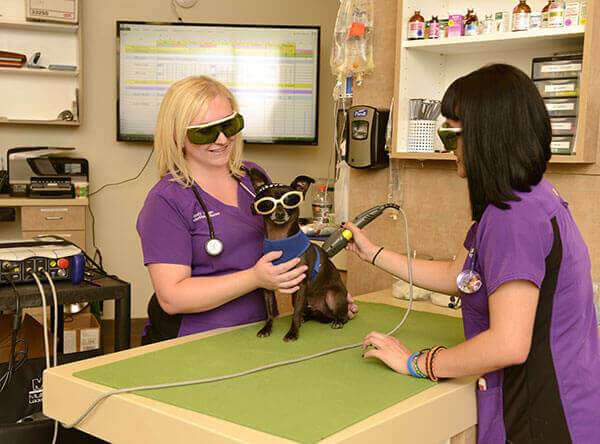As a loving and responsible dog owner, you’re probably willing to do just about anything to ensure your canine companion’s health and happiness. Like humans, though, they can suffer from a wide range of painful conditions. Many things can decrease your dog’s quality of life, from acute injuries and surgical incisions to degenerative joint disease and other chronic problems. When it comes to something as crucial as your dog’s comfort and well-being, you are bound to have questions. That’s why we’ve created this resource on dog laser therapy, answering the most frequently asked questions on laser therapy for dogs.
However, if you still have questions about laser therapy for your dog and are in the Las Vegas, NV area, give us a call at (702) 675-7000.
How is laser therapy used to treat dogs?
 As veterinarians, we use laser therapy to treat many different conditions in dogs. During treatment, we shine the focused laser beam at the specific area we are treating. The cells absorb that light and become more active, resulting in increased blood flow and accelerated healing.
As veterinarians, we use laser therapy to treat many different conditions in dogs. During treatment, we shine the focused laser beam at the specific area we are treating. The cells absorb that light and become more active, resulting in increased blood flow and accelerated healing.
Why should I consider laser therapy for my dog?
Laser therapy can improve a dog’s quality of life. If your dog is in pain and/or on medications due to an issue like hip dysplasia or another problem, laser therapy can provide relief. Since laser therapy does not require medication or anesthesia, it does not cause added concern for older pets with decreased organ function. You may also want to consider laser therapy after your dog has surgery. It is commonly used at the incision site following spays, neuters, and other procedures to decrease pain and inflammation and help the wound heal faster.
Other situations in which you might want to consider laser therapy for your dog include:
- Severe ear infections
- Fractures
- Arthritis
- Degenerative joint disease
What are the different laser therapies, and when might the veterinarian recommend them for my dog?
The only major modality for therapeutic laser treatments is a low-level, frequency-specific laser. What this means is that it does not cut or burn tissue. “Frequency-specific” means that the laser targets specific cells in the injured area. If, for instance, your dog has an anterior cruciate ligament (ACL) tear in their knee, we’ll use the laser to target those ligaments and connective tissue cells. We will also target the joint, muscle, and inflammatory cells to encourage them to work together to ease pain and facilitate healing.
Other lasers on the market may be too high-powered for this type of therapy. While they can still decrease inflammation and ease pain, they do not affect biomodulation. Only low-level lasers can change tissues and encourage healing. When caring for your canine companion, you need a therapeutic laser that takes away pain and discomfort while affecting biomodulation and changing tissues for the better.
What conditions can laser therapy treat in my dog?
We use laser therapy to treat several conditions and injuries in dogs. Laser therapy is one of our preferred treatment modalities for anterior cruciate ligament tears and arthritis. We commonly treat senior dogs, which is very rewarding. Dogs that take several pain medications require blood work every two months to assess liver and kidney function. Discontinuing those medications, or significantly decreasing their dosages, is one of the most beneficial things we can do with laser therapy.
Other conditions we treat using laser therapy include:
- Skin infections or superficial wounds
- Disc injuries
- Neck issues, especially in brachycephalic dogs
- Chronic ear inflammation
- Acute injuries
- Post-operative pain
- Chronic joint pain/arthritis
What can I expect from my dog's laser therapy appointment?
During treatment, you can expect your dog to receive lots of love, cuddles, and treats. Once they are lying down comfortably, we touch the handheld laser device to your pet’s body in the treatment area. The device emits light that penetrates the skin and fur to trigger healing responses in the cells. To your dog, it feels like getting a gentle massage.
How long will a laser therapy session last for my dog?
Typically, a laser therapy session includes treating your pet at three or four different sets of frequency, and each set takes about three minutes. This usually results in sessions that range from 15 to 20 minutes in length. However, the exact treatment time varies depending on what we are treating. Arthritis in your dog’s knees and hips, for example, would take longer than treating a single surgical incision or an ear infection.
How many laser therapy sessions will my dog need?
The number of sessions your dog needs varies depending on the nature and chronicity of the problem. Acute issues usually only require five to seven treatments. For more chronic issues — like ACL tears or back pain — your canine companion will likely need 14 to 15 treatments spread out over time. We will make recommendations based on your dog’s unique needs and discuss these with you before beginning treatment.
What are the risks of laser therapy?
Laser therapy poses very little to no risk to your dog. In fact, this treatment is so safe we don’t even have to wear safety equipment. And because it is such a low-level laser, there is no risk of skin burns. Lasers use specific frequencies to treat particular cell types, so even if your dog has cancer, there’s no risk of “feeding” the disease with the laser. Laser therapy is non-invasive, pain-free, and promotes the body’s natural healing processes, so health risks are virtually non-existent with this treatment modality.
How will I know if laser therapy is working for my dog?
In most cases, you can easily see whether laser therapy is working for your dog. They’ll seem happier, get around easier, and have less trouble going up and down stairs or climbing on the sofa. Suppose your dog has been lethargic due to pain and discomfort and suddenly starts bringing you their toy, or looking forward to walks again after beginning laser therapy. In that case, these are all clear indications that the treatment is working. When treating ear infections, decreased inflammation and redness show that laser therapy is helping. And if we are treating a surgical incision using the modality, seeing the wound getting smaller shows that it’s working.
If you still have questions about dog laser therapy, we would love to help! As skilled veterinarians in Las Vegas, NV, we are here to address any questions or concerns you may have and give your dog the loving care they need. Reach out to us today by calling (702) 675-7000.

